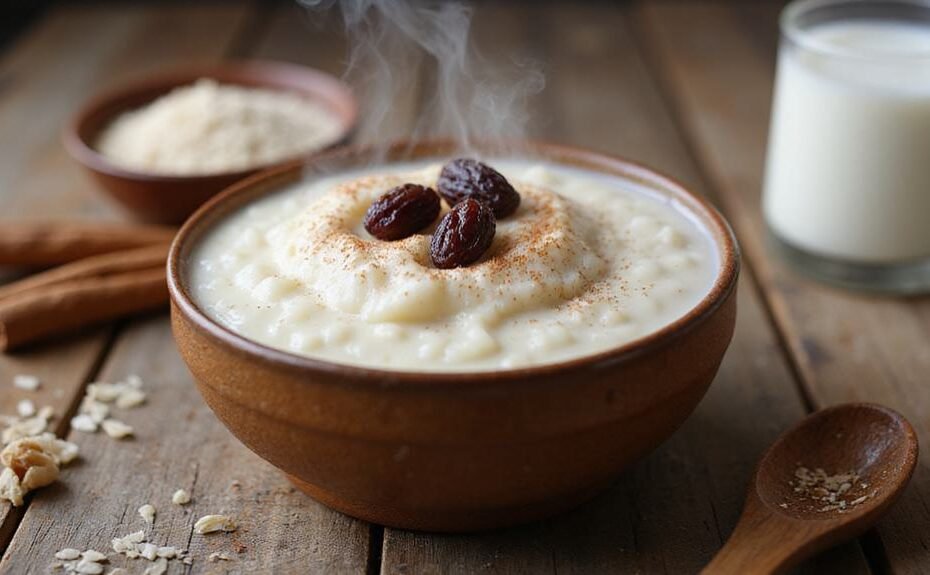Rice Pudding
Rice pudding is a dessert made from rice cooked with milk or cream, sweeteners, and sometimes additional flavors like vanilla, cinnamon, or raisins, creating a creamy, comforting dish that provides complex carbohydrates, protein, calcium, and energy while varying in nutritional profile depending on ingredients used.
The nutritional benefits, potential side effects, suitable dietary applications, variations across cultures, homemade versus store-bought comparisons, and considerations for people with diabetes or dietary restrictions, is explored in this post, below.
Trumpai
- Rice pudding provides complex carbohydrates, calcium, and magnesium, supporting bone health and sustained cognitive function.
- Potential side effects include blood sugar spikes, digestive issues for those with lactose intolerance, and weight gain if overconsumed.
- Recommended servings are 1/4 to 1/2 cup, with optimal preparation using a 6:1 milk-to-rice ratio and continuous stirring.
- Rice pudding contains 130-280 calories per serving with 24-48g carbohydrates, 3-7g fat, and 3-8g protein.
- Versatile as both dessert and breakfast, it pairs well with fruits, nuts, and spices like cinnamon or nutmeg.
Potential Benefits
Rice pudding may provide complex carbohydrates for sustained glucose release, enhance cognitive function, contribute to bone development through calcium and magnesium content, promote digestive health with fiber, and bolster immune function through iron.
Rice pudding may offer numerous physiological benefits supported by its nutritional profile. The complex carbohydrates may provide sustained glucose release, potentially enhancing cognitive benefits through stable blood sugar levels that optimize brain function.
Its calcium and magnesium content may contribute to bone development and muscle support, with studies showing improved muscle mass measurements in preschool interventions.
The fiber in rice pudding may promote digestive health, while iron content may bolster immune function and reduce fatigue.
Its nutritional adaptability may allow for fortification with additional nutrients through milk alternatives or add-ins like nuts and seeds. Research may indicate positive growth metrics in children consuming rice-based interventions.
When prepared with low-fat ingredients or plant-based alternatives, rice pudding may accommodate diverse dietary requirements while maintaining its beneficial properties.
Drinking water alongside rice pudding may help with proper digestion and nutrient absorption. For specific dietary recommendations, please consult with a doctor who can provide personalized advice based on individual health needs.
Nutritional Information, Calories
Nutritional Information, Calories
Rice pudding contains 130-280 calories per serving, with 24-48g of carbohydrates (68-80% of total calories), 3-7g of fat (7-21% of calories), and 3-8g of protein.
Complete Nutritional Profile:
Rice pudding may provide:
Macronutrients (per serving):
- Carbohydrates: 24-48g (predominant nutrient with minimal fiber)
- Fat: 3-7g (varies based on dairy components used)
- Protein: 3-8g (primarily from dairy and eggs when included)
Vitamins & Minerals:
- Calcium: May be significant from dairy ingredients
- Vitamin D: May be present if fortified milk is used
- B Vitamins: May include small amounts from dairy and rice
- Phosphorus: May be present from dairy components
Caloric Variations:
- Homemade versions: 192-280 calories per serving
- Commercial products: 130-150 calories per standard portion
- Portion sizes: Vary from 106g (commercial) to 130g (half-cup serving)
Higher calorie versions may contain added sugars or evaporated milk.
Commercial formulations generally prioritize carbohydrate content over protein or fat.
Rice pudding may be found in various forms including ready-to-eat commercial cups, homemade preparations, and restaurant dessert menus.
Dosage (serving size) may vary by individual needs. If concerned about caloric intake, please consult with a doctor or your personal trainer before including rice pudding regularly in your diet.
Drinking water alongside dessert dishes like rice pudding may help with digestion.
Potential Side Effects
Potential side effects of rice pudding may include blood sugar spikes, gastrointestinal issues, and weight management challenges.
Rice pudding may cause rapid blood sugar elevations due to the high glycemic impact of rice’s amylopectin, potentially worsening insulin resistance in diabetic patients and triggering compensatory insulin surges.
Gastrointestinal problems may occur from several components. Wheat germ agglutinin present in rice may irritate the intestinal lining, while dairy-based varieties may cause issues for those with lactose intolerance.
Individuals with IBS may experience symptom exacerbation due to FODMAP sensitivity when consuming certain pudding formulations.
The high caloric density of rice pudding may contribute to weight management difficulties, as its palatability often leads to portion control challenges.
Drinking water is important when consuming rice pudding to help with digestion.
Those with specific conditions including gallbladder dysfunction, histamine sensitivity, or food allergies may need to exercise particular caution.
Cross-contamination risks may exist even in gluten-free varieties, so please consult with a doctor before consuming if you have these conditions.
Use and dosage recomendations
Use and Dosage Recommendations
Rice pudding servings may be 60 ml (1/4 cup) or 120 ml (1/2 cup), providing approximately 150 calories with 4% fat content, aligning with balanced nutrition guidelines.
For optimal preparation:
- Use a 6:1 milk-to-dry rice ratio (may vary by recipe)
- Combine heat-tempered eggs with evaporated milk
- Stir continuously during boiling to prevent curdling
Portion control may be achieved using prepackaged single-serving containers or measuring specific amounts to avoid exceeding daily saturated fat limits.
Storage requires refrigeration to enhance texture, with bulk preparation options available for meal planning efficiency.
Medium-grain rice may produce thicker consistency, while long-grain varieties may offer lighter textures suitable for different dietary preferences.
Drinking water is recommended alongside consumption.
Dosage may vary by individual, so please consult with a doctor before making significant changes to your diet.
Compared to Oatmeal Desserts
Rice Pudding vs. Oatmeal Desserts
Nutritional Comparison
- Rice pudding contains higher calories (216 kcal/cup) than oatmeal desserts (145 kcal/cup).
- Rice pudding provides significantly less protein (2.2g vs. 5.5g per serving).
- Oatmeal desserts offer superior glycemic control with lower glycemic index.
- Oatmeal contains more antioxidants that combat free radicals.
Preparation Differences
- Rice pudding requires prolonged simmering with milk for creaminess.
- Oatmeal desserts can be prepared with convenient overnight soaking methods.
Flavor & Consumption Considerations
- Oatmeal naturally absorbs spices like cinnamon and pairs well with nuts/seeds.
- Rice pudding typically incorporates fruit preserves and requires more added sugars.
- Rice pudding may cause greater blood sugar fluctuations (concerning for diabetics).
Key Attributes
- Texture: Rice pudding is creamier; oatmeal offers more textural variety.
- Digestibility: Oatmeal provides more fiber and slower digestion.
- Versatility: Both can be adapted for various dietary needs.
What diseases or symptoms can this potentially help treat or alleviate?
Rice pudding may help treat diabetes, heart health issues, and digestive discomfort. Rice pudding‘s effectiveness for health conditions largely depends on its nutritional composition and preparation methods. When made with brown rice and minimal added sugars, it offers therapeutic properties that may assist with various conditions.
- Diabetes Management – The fiber in brown rice-based pudding may slow carbohydrate digestion, potentially stabilizing blood glucose levels and preventing dramatic spikes, especially when portion-controlled and paired with protein.
- Heart Health – Soluble fiber found in rice pudding made with brown rice may help reduce total and LDL cholesterol levels, while its antioxidant content may mitigate inflammation associated with cardiovascular disease.
- Digestive Comfort – The gentle, soft texture combined with soluble fiber may promote healthy digestion, potentially alleviating constipation and supporting regular bowel movements when consumed as part of a balanced diet.
For any health condition, please consult with a doctor before using food as therapeutic intervention.
Drinking water alongside rice pudding may help maximize its digestive benefits.
Frequently Asked Questions
Can Rice Pudding Be Made With Non-Dairy Milk Alternatives?
Yes, rice pudding can be made with non-dairy milk alternatives. Various non-dairy options including almond, coconut, and oat milk may provide adequate consistency when properly thickened and may benefit from flavor enhancements like vanilla and cinnamon. When preparing rice pudding, the selection of non-dairy milk, rice texture, sweetener type, and cooking method are important attributes to consider for optimal results.
How Long Does Homemade Rice Pudding Last in the Refrigerator?
Homemade rice pudding lasts 3-5 days in the refrigerator. It may extend to 1 week with proper storage tips. Shelf life may vary based on ingredients, with dairy versions possibly expiring faster than plant-based alternatives. Important factors affecting rice pudding storage include temperature, container sealing, and ingredient freshness. For optimal results, store rice pudding at 0-4°C (32-39°F) in an airtight container and ensure proper refrigeration to maintain quality and prevent spoilage.
Is Rice Pudding Suitable for Babies and Toddlers?
Yes, rice pudding may be suitable for babies and toddlers. For babies 10+ months old, it may be appropriate when prepared with infant formula. For toddlers, recipes may benefit from limited added sugars while potentially providing beneficial calories and nutrients. When preparing rice pudding for infants, parents may need to adjust consistency by adding more formula or breast milk. Rice pudding may offer beneficial nutrients including calcium, protein, and carbohydrates for growing children. If serving store-bought versions, parents may want to check ingredient lists for excessive sugars, preservatives, and additives. Regarding portion size, it may vary depending on individual needs, please always consult with a doctor before introducing new foods to babies and toddlers. Rice pudding preparation temperature should not exceed 60°C when serving to children to prevent burns.
Can Rice Pudding Be Frozen for Later Consumption?
Yes, rice pudding can be frozen for later consumption. Rice pudding may be frozen for up to three months when stored in airtight containers. Freezing tips may include leaving expansion space in containers and labeling with dates. Storage methods may prevent freezer burn for ideal preservation of the pudding. Rice, pudding, dessert, freezing methods, and storage duration are important aspects to consider when preserving rice pudding.
What Are Traditional Rice Pudding Variations From Different Cultures?
Traditional rice pudding variations from different cultures include Italian Arborio with rich cream, Indian Kheer with cardamom, Spanish Arroz with cinnamon, Greek Rizogalo with lemon, Caribbean Rice with coconut, and Middle Eastern Muhallebi with rose water. Italian Arborio rice pudding may be made with creamy textures and vanilla flavoring. Indian Kheer may contain cardamom, saffron, and nuts for aromatic sweetness. Spanish Arroz con Leche may feature cinnamon sticks and citrus zest. Greek Rizogalo may incorporate lemon peel for brightness. Caribbean rice pudding may blend coconut milk with tropical spices. Middle Eastern Muhallebi may be perfumed with rose water and topped with pistachios. The most important elements in rice pudding across cultures may include the type of rice used, sweetening agents, spices, and cooking liquids like milk or coconut milk.
References
- https://www.baladna.com/en/blog/rice-pudding-is-it-a-healthy-snack
- https://biomedres.us/pdfs/BJSTR.MS.ID.001346.pdf
- https://baladna.com/en/blog/14-reasons-why-eating-rice-pudding-is-a-brilliant-choice
- https://actascientific.com/ASNH/pdf/ASNH-04-0750.pdf
- https://www.mayoclinic.org/healthy-lifestyle/recipes/fruited-rice-pudding/rcp-20049782
- https://www.kozyshack.com/products/original-puddings/rice-pudding
- https://www.eatthismuch.com/calories/rice-pudding-155434
- https://www.myplate.gov/recipes/rice-pudding
- https://www.mynetdiary.com/food/calories-in-homemade-rice-pudding-by-wegmans-cup-28471607-0.html
- https://www.thefreshgrocer.com/product/seor-rico-rice-pudding-375-oz-4-count-id-00044276056125

